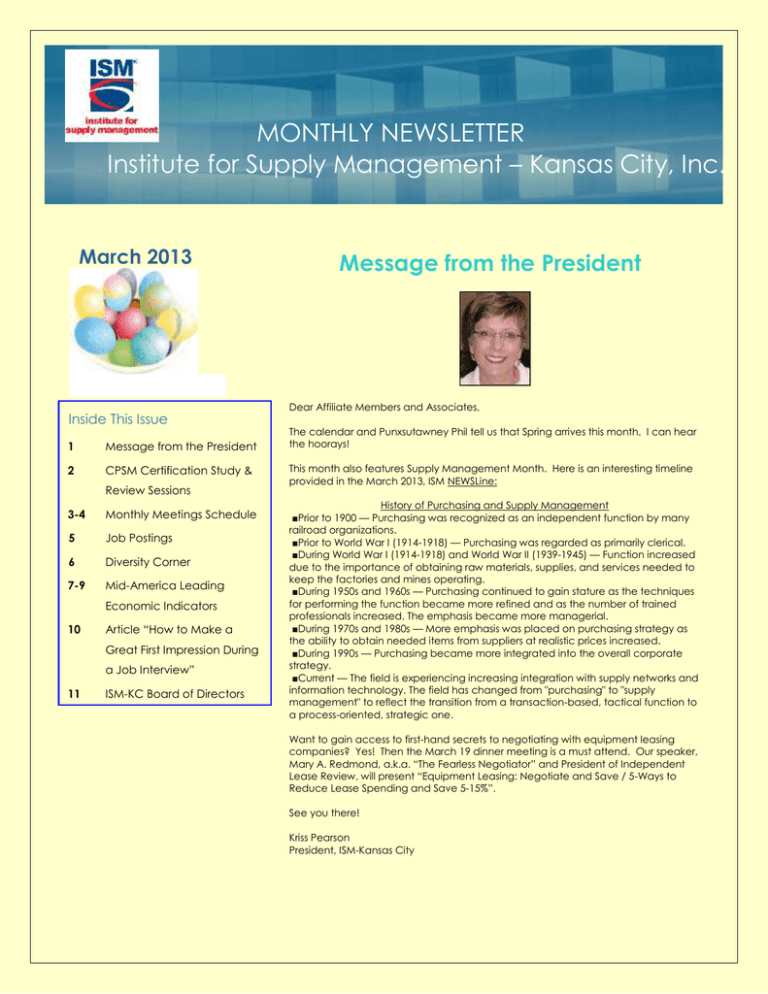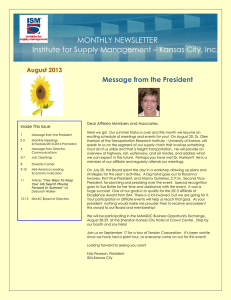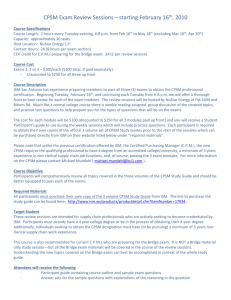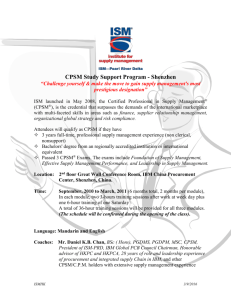Message from the President
advertisement

MONTHLY NEWSLETTER Institute for Supply Management – Kansas City, Inc. March 2013 Inside This Issue 1 Message from the President 2 CPSM Certification Study & Review Sessions 3-4 Monthly Meetings Schedule 5 Job Postings 6 Diversity Corner 7-9 Mid-America Leading Economic Indicators 10 Article “How to Make a Great First Impression During a Job Interview” 11 ISM-KC Board of Directors Message from the President Dear Affiliate Members and Associates, The calendar and Punxsutawney Phil tell us that Spring arrives this month. I can hear the hoorays! This month also features Supply Management Month. Here is an interesting timeline provided in the March 2013, ISM NEWSLine: History of Purchasing and Supply Management ■Prior to 1900 — Purchasing was recognized as an independent function by many railroad organizations. ■Prior to World War I (1914-1918) — Purchasing was regarded as primarily clerical. ■During World War I (1914-1918) and World War II (1939-1945) — Function increased due to the importance of obtaining raw materials, supplies, and services needed to keep the factories and mines operating. ■During 1950s and 1960s — Purchasing continued to gain stature as the techniques for performing the function became more refined and as the number of trained professionals increased. The emphasis became more managerial. ■During 1970s and 1980s — More emphasis was placed on purchasing strategy as the ability to obtain needed items from suppliers at realistic prices increased. ■During 1990s — Purchasing became more integrated into the overall corporate strategy. ■Current — The field is experiencing increasing integration with supply networks and information technology. The field has changed from "purchasing" to "supply management" to reflect the transition from a transaction-based, tactical function to a process-oriented, strategic one. Want to gain access to first-hand secrets to negotiating with equipment leasing companies? Yes! Then the March 19 dinner meeting is a must attend. Our speaker, Mary A. Redmond, a.k.a. “The Fearless Negotiator” and President of Independent Lease Review, will present “Equipment Leasing: Negotiate and Save / 5-Ways to Reduce Lease Spending and Save 5-15%”. See you there! Kriss Pearson President, ISM-Kansas City PAGE 2 ISM-KANSAS CITY NEWSLETTER Certification Free Trial CPSMCPSM/CSM Review Class ISM Kansas City is going to conduct an experiment in CPSM review classes. This experiment will consist of covering as much material as possible in one day. This class will be on Saturday, March 23 at the Johnson County Library at Shawnee Mission Parkway and Antioch. This is just east of I-35 in Kansas at the Shawnee Mission Parkway exit. The time will be 9 to 5. Since this class is a free trial, there will be no charge for this class. Students will receive 7 continuing education credit hours, which can be applied to a C.P.M. or current CPSM renewal. Requirements: RSVP to joe.steve@kcpl.com. Please RSVP, if possible. Send your cell phone number – in case there is some Saturday morning meeting room problem. If you don’t RSVP but can attend, feel free to come on over but we might not have handouts. Suggestions: It is highly suggested that students have an ISM CPSM Study Guide. This book set is $79 and is available from www.ism.ws. Students should also bring a notepad, pen, and especially a highlighter. There is a handout and participant guide set available for the class from the instructor for $20, which is very helpful but not mandatory. Please indicate on your RSVP if you would like a handout set. If you take the class and like it, Excellent! That is the idea. If you desire you can then continue self study for the CPSM, or you can sign up for the next complete set of CPSM review classes ISM Kansas City offers, your choice. Thanks for being a supporter of ISM Kansas City! Joe Steve Joe.steve@kcpl.com Cell # 816-806-0194 ISM-KANSAS CITY NEWSLETTER PAGE 3 2012-2013 Monthly Meeting Schedule (Note: Dates Have Been Corrected From June Newsletter) March 2013 Lunch Meeting Equipment Leasing: Negotiate and Save Tue, Mar 19, 2013 5:30 PM - 7:30 PM Hallmark HQ, MO 2501 McGee Trafficway enter the parking lot at 25th & Gillham on the North side of the Church Kansas City, Missouri 64108 Fees for this event: MEMBERS (1.0000 POINTS): $25.00 NON-MEMBERS: $25.00 Topic: Equipment Leasing: Negotiate and Save/ 5 Ways to Reduce Lease Spending and Save 5-15% Speaker Mary A. Redmond, President/ Independent Lease Review, Inc. The Department of Commerce reports that 80% of all companies lease equipment. In 2011, IHS Global’s Equipment Market Monitor Studies report that over $664 billion dollars of equipment and software were financed. Equipment financing projections for 2012 are expected to have reached $725 billion. Businesses continue to face unprecedented economic challenges. Large and small corporations are in survival mode as they search for keys to: Remain profitable Increase revenue Retain skilled and valuable employees Maximize return on investment (ROI) Finance growth After nearly 30 years successfully negotiating leases, Mary Redmond, The FearLess Negotiator, knows how equipment leasing companies do business. She unlocks the secrets only leasing insiders know. This session reveals the camouflaged areas in equipment leases that can increase costs. Surprises include termination penalties, fees, automatic renewals and “not-so-fair” market value buyouts. Learn how to analyze and negotiate leases from a savvy leasing industry veteran. You will have the tools to improve your company’s ROI. PAGE 4 ISM-KANSAS CITY NEWSLETTER You will learn: 1. 2. 3. 4. Critical financial details to make informed business decisions that increase your ROI. Details that may make or break your ROI analysis. What attorneys and accountants seldom negotiate. FIVE contract changes that will save you money. Learn more by watching the Video clip “LeaseSpeakTM Workshop” http://www.leasespeak.com/meetingplanners.htm To register go to https://www.ism-kansascity.org/ Park in the Corporate Lot (enter the parking lot at 25th & Gillham on the North side of the Church) and enter the building at the 8D entrance. The meeting will be in the Multipurpose Room in the Rice Innovation Center which sits on top of the Hallmark Garage on the map. The map will be email to all upon registration. April 16, 2013 – Current Events and the Impact on the Economy - Guest Speaker: Mr. Chris Kuehl - Managing Director - Armada Corporate Intelligence (Location: TBD) (more details can be found at https://www.ism-kansascity.org/) May 21, 2013 - TBD ISM-KANSAS CITY NEWSLETTER PAGE 5 Job Posting New Job Opportunities Posted on ISM-KC Web Site, go to: http://www.ism-kansascity.org/default.asp Log In Select Members Select Job Postings Click on each job for details Please view the job postings regularly as new jobs are posted throughout the month. PAGE 6 ISM-KANSAS CITY NEWSLETTER MID AMERICA MINORITY SUPPLIER DEVELOPMENT COUNCIL (MAMSDC) DIVERSITY CORNER MAMSDC can help you and your company take advantage of the products and services offered by diverse businesses. Let MAMSDC help you to: Develop a Diversity Program for your company Locate diverse companies in the local area to meet your product and service needs Locate diverse companies outside the area as well In a time where most large companies only offer cookie cutter products and services, diverse businesses can offer custom solutions to meet your needs. So get started, click here www.mambdc.org Upcoming Events: Register at www.mambdc.org ISM-KANSAS CITY NEWSLETTER PAGE 7 Mid-American States Mid-America Indicator Expands for February: One-Third Expect Negative Fallout from Sequestration February survey results at a glance: · Leading economic indicator expands to its highest level since June of last year. · Export orders remain weak. · More than one-third of companies surveyed expect the federal spending sequestration to result in a reduction in unit sales for their company. · Almost half of firms indicated they had expanded sustainable procurement of raw materials and supplies. For Immediate Release: March 1, 2013 OMAHA, Neb. – The monthly Mid-America Business Conditions Index, a leading economic indicator for a nine-state region, dipped slightly for the month. The index is pointing to sluggish growth for the region in the next three to six months. Overall index: The Business Conditions Index, which ranges between 0 and 100, decreased to a tepid 53.1 from 53.2 in January. “Much like the national economy, the economic trajectory of the Mid-America region will remain on a sluggish course. Even though the housing sector is clearly getting back on its feet, manufacturing, especially manufacturing connected to global markets, continues to restrain overall growth for the region and nation,” said Ernie Goss, director of Creighton University’s Economic Forecasting Group and the Jack A. MacAllister Chair in Regional Economics. Employment: After moving below growth neutral for January, the region’s employment gauge climbed above 50.0 for February. Even so, the February reading stood at a weak 51.6, but was up from January’s 48.9. “Employment readings over the past several months are consistent with little to no job growth in the region in the next three to six months,” said Goss. Wholesale Prices: The prices-paid index, which tracks the cost of purchased raw materials and supplies, advanced to 72.6 from 71.8 in January. “The Federal Reserve Open Market Committee, which sets U.S. interest rate policy remains committed to their current aggressive ‘cheap’ money policy. While it has not sparked any significant inflationary pressures for U.S. consumers, this policy is boosting our wholesale inflation gauge and is pushing U.S. asset prices up at a pace that is causing disruptions in certain sectors of the economy such as agriculture,” said Goss. Confidence: Looking ahead six months, economic optimism, as captured by the February business confidence index, sank to 50.6 from January’s 56.6. “This month we asked supply managers how the upcoming sequestration would affect their company’s sales. More than one-third, or 35.1 percent, expect the cut in federal spending to result in a reduction in unit sales for their company. It is clear that this had a negative impact on supply manager’s economic outlook this month,” said Goss. As reported by one supply manager, “Sequestration is a big question mark for us since we do a lot with first tier suppliers to the government.” PAGE 8 ISM-KANSAS CITY NEWSLETTER Inventories: Regional inventory levels increased for the month but at slower pace compared to January. The February inventory index declined to 52.2 from January’s 55.0. “Companies in our survey have now expanded inventory levels for three straight months. This inventory accumulation will add slightly to regional growth in the months ahead,” said Goss. Companies in the region continue to expand “sustainable” procurement policies. This month, almost half, or 47.6 percent, of firms indicated that they had expanded sustainable purchases of raw materials and supplies. On the other hand, 45.2 percent reported no change and 7.2 reported a reduction in sustainable buying. Trade: New export orders remain weak for the region. The new export orders index increased to a frail 49.2 from January’s 45.3. On the other hand, imports advanced to 53.7 from 50.7 for January. “As our overall regional gauge moved above growth neutral for February, so did purchasing from abroad. On the other hand, economic weakness among the region’s important trading partners weighed on exports,” said Goss. Other components: Other components of the February Business Conditions Index were new orders at 55.0, up from 52.3 in January; production or sales at 55.5, up from 53.9; and delivery lead time at 51.1, down from 56.1 in January. The Creighton Economic Forecasting Group has conducted the monthly survey of supply managers in nine states since 1994 to produce leading economic indicators of the Mid-America economy. States included in the survey are Arkansas, Iowa, Kansas, Minnesota, Missouri, Nebraska, North Dakota, Oklahoma and South Dakota. The forecasting group’s overall index, referred to as the Business Conditions Index, ranges between 0 and 100. An index greater than 50 indicates an expansionary economy over the course of the next three to six months. The Business Conditions Index is a mathematical average of indices for new orders, production or sales, employment, inventories and delivery lead time. This is the same methodology used by the National Institute for Supply Management, formerly the Purchasing Management Association, since 1931. Arkansas: The February overall index for Arkansas dipped to 51.1 from 52.3 in January. Components of the index from the February survey of supply managers were new orders at 44.5, production or sales at 49.0, delivery lead time at 62.5, inventories at 50.0, and employment at 49.4. “Over the past year, the state’s unemployment rate has declined by seven tenths of one percentage point. However, a large part of this decline was the result of approximately 23,000 workers leaving the work force. Our surveys point to a continuation of this weak hiring market, especially for smaller manufacturers as they struggle with impending mandates from healthcare reform,” said Goss. Iowa: For a second straight month, Iowa’s Business Conditions Index increased. The overall index from a survey of supply managers in the state climbed to 64.6, a regional high, from 59.8 in January. Iowa’s leading economic indicator has now moved above growth neutral for 38 straight months. Components of the index for February were new orders at 70.7, production or sales at 71.1, delivery lead time at 58.4, employment at 62.5, and inventories at 60.3. “For the first time since the economic recovery began in 2009, Iowa’s unemployment rate has moved below 5 percent. Businesses in the state tied to energy and agriculture continue to experience healthy growth. Our surveys indicate that economic growth for Iowa will remain healthy for the next three to six months,” said Goss. Kansas: The Kansas Business Conditions Index for February expanded to 54.1 from January’s 48.3. Components of the leading economic indicator from the monthly survey of supply managers were new orders at 57.2, production or sales at 56.2, delivery lead time at 50.5, employment at 49.7, and inventories at 56.7. “The state’s unemployment rate has declined by a full percentage point over the past year. However during this same period of time, Kansas has lost more than 7,000 jobs and approximately 22,000 workers left the state’s labor market. Our surveys over the past several months point to sluggish, but positive business and job growth for the next three to six months,” said Goss. Minnesota: For a third straight month, Minnesota’s Business Conditions Index moved above growth neutral. The index from a monthly survey of supply managers in the state declined to 52.0 from 52.6 in January. Components of the index from the February survey were new orders at 44.8, production or sales at 50.5, delivery lead time at 56.2, inventories at 52.7, and employment at 51.7. “Over the past year, Minnesota’s unemployment rate has declined by approximately one-half of one percentage point. However, job growth has been sluggish over this same period of time. Our surveys over the past several months point to a continuation of this trend with very slow job growth. Minnesota firms depending heavily ISM-KANSAS CITY NEWSLETTER PAGE 9 on exports have been negatively affected by slowing global economic pullbacks. On the positive side, firms linked to agriculture continue to experience healthy growth,” said Goss. Missouri: The February Business Conditions Index for Missouri advanced to 52.1 from January’s 51.2. Components of the survey of supply managers in the state were new orders at 51.8, production or sales at 50.9, delivery lead time at 53.8, inventories at 47.1, and employment at 57.0. “Missouri’s unemployment rate continues to move lower with the current jobless rate down a full three percentage points since the national economic recovery began in 2009. Heavy or durable goods manufacturers in the state, such as metal producers, continue to experience healthy growth while nondurable goods producers are encountering downturns in economic activity. Over the next three to six months, Missouri’s economic growth will slow but remain positive according to our surveys,” said Goss. Nebraska: For the second time in the past three months, Nebraska’s leading economic indicator sank below growth neutral. The Business Conditions Index, from a survey of supply managers, tumbled to 48.7 from January’s 50.5, but was up slightly from December’s 48.4. Components of the index for February were new orders at 50.2, production or sales at 47.5, delivery lead time at 48.8, inventories at 52.8, and employment at 44.3. “Contrary to other states in the region, Nebraska’s unemployment rate has declined and the labor force has expanded since the national expansion began in 2009. However according to our surveys over the past several months this very positive trajectory is now ending with slow to no growth projected for the next three to six months,” said Goss. North Dakota: For a third straight month, North Dakota’s leading economic indicator is pointing to softer but still positive economic growth in the next three to six months. The index expanded to 54.4 from January’s 53.8. Components of the overall index for February were new orders at 62.1, production or sales at 69.5, delivery lead time at 50.4, employment at 52.8, and inventories at 37.1. “As a result of very strong economic growth, North Dakota’s labor force participation rate, the share of the population that is working or looking for work, is the highest in the nation and its unemployment rate is the lowest in the nation. Thus, companies in the state are having increasing difficulty recruiting additional workers even as their new orders continue to expand at a very healthy pace. As a result, labor shortages are the chief inhibitor to more robust growth in North Dakota in the months ahead,” said Goss. Oklahoma: The Business Conditions Index for Oklahoma moved above growth neutral for February. The leading economic indicator from a monthly survey of supply managers dipped to 52.5 from 53.8 in January. Components of the February survey of supply managers in the state were new orders at 51.7, production or sales at 48.4, delivery lead time at 49.0, inventories at 62.4, and employment at 51.0. “Since the recovery began in 2009 and contrary to the nation, Oklahoma’s unemployment rate has declined by two percentage points and the state’s labor force has expanded by almost 40,000 workers. Durable goods manufacturers such as metal product producers are reporting very healthy growth while nondurable manufacturers including food processors are detailing pullbacks in economic activity. Based on our survey results over the past several months, Oklahoma growth will continue on a positive, but slower pace,” said Goss. South Dakota: For a third straight month, South Dakota’s leading economic indicator from a survey of supply managers rose above the 50.0 threshold to 52.5 from January’s 53.5 and December’s 51.9. Components of the index for February were new orders at 47.9, production or sales at 55.2, delivery lead time at 49.1, inventories at 52.4, and employment at 49.2. “Since the recession ended in 2009, South Dakota’s unemployment rate has declined by almost one percentage point. Manufacturing growth has been an important factor contributing to the lower jobless rate. Recent surveys indicate that overall and manufacturing growth will continue to be positive but slower,” said Goss. Survey results for March will be released on the month’s first business day, April 1. Follow Goss on twitter at http://twitter.com/erniegoss For historical data and forecasts visit our website at: http://www2.creighton.edu/business/economicoutlook/ www.ernestgoss.com PAGE 10 ISM-KANSAS CITY NEWSLETTER How To Make a Great First Impression In a Job Interview The first few minutes of a job interview are critically important for creating a good first impression. In fact, the first 30 seconds can make you or break you. Interviewers gather clues about you based on the way you look, how you shake hands, the eye contact you make and the first words that come out of your mouth. It pays to have a strategy for creating a great first impression every time you interview. Here are five tips for starting your interview off on the right foot. 1. Dress for the White House. If you were invited to interview with the President of the United States in the Oval Office, there would be no question in your mind as to the level of professionalism you'd want to portray. Your grooming would be impeccable, your clothes spotless and lint free, your shoes in perfect condition. Yet job seekers often make the mistake of dressing too casual for job interviews. Never dress business casual for a job interview. Your suit should be classic in style, and conservative in color. Women, don't wear low necklines or short skirts. Men, make sure your shirt is pressed to perfection and you tie isn't too loud. Likewise, avoid all perfumes, scented deodorants and aftershave lotions. By the way you dress you announce to the interviewer how important you see him and his company. 2. Your handshake tells all. Remember when deals were made on a handshake? That should give you an idea of how important society views the handshake. Your interviewer will read your character in your handshake. He'll decide how honest you are by the way you shake his hand. A limp handshake reveals lack of interest. An aggressive handshake gives the impression of an overly eager or desperate candidate. A tip-of-the-fingers shake says lack of sincerity. Sweaty palms shows fear. If handshaking isn't part of your daily routine, chances are your handshake is less than what it ought to be. The best way to practice is to go to some kind of social event where you'll have the opportunity to meet many new persons. Make it a game to shake as many hands as you can. See what you can read in others by the way they shake hands. Use the time to perfect your handshake so that your next interview you'll stick out your hand with confidence. 3. Mirror your interviewer. The quickest way to connect with your interviewer is to mirror their speaking style. If he speaks fast, you speak fast. If he has a slow manner of speaking, so do you. More importantly, you must match the level of detail that your interviewer speaks with. There are some people that communicate very directly. When asked a question, they answer in the shortest manner possible. Others are story tellers who embellish their language with plenty of details. You must listen very carefully to your interviewer to discover their level of detail in communicating. If you provide too much detail to one who is direct, you will overload them with what they see as extraneous information. They will quickly loose interest in you. On the other hand, if you are too direct in your answers to one who enjoys details they will suspect that you are trying to hide facts. It's true that you only have one opportunity to make a first impression. If you blow the first few minutes of your interview you may have lost your chance at a great job. Remember, you'll most likely interview several people for each job opportunity. You'll have to make a great first impression with each interviewer. Don't get lax in your firstimpression strategy. Use these tips for each and every person you interview with and you'll be on your way to your next best career opportunity. ~~~~~~~~~~~~~~~~~~~~~~~~~~~~~~~~~~~~~~~~~~~~~~~~~~~~~~~~~~~~~~~~~~~~~~~~~~~~~~~ Deborah Walker, Certified Career Management Coach Read more career tips and see sample resumes at: www.AlphaAdvantage.com email: Deb@Alphaadvantage.com 360-260-4965 ISM-KANSAS CITY NEWSLETTER PAGE 11 ISM Kansas City Board of Directors President Kriss Pearson Laird Plastics kpearson@lairdplastics.com 1st Vice President Manuel Gutierrez, C.P.M. CenturyLink manuel.gutierrez@centurylink.com Director National Affairs & Past President LaMar Wilson, Jr. NAIC lwilson@naic.org Treasurer Joel Johnson, CPSM joel.johnson10@gmail.com Secretary JoAnn Harper, CPSM, C.P.M. Sprint JoAnn.S.Harper@sprint.com Director - Diversity Asya Evans MidAmerica Minority Business Development Council – KC asya.evans@mambdc.org Director – Marketing Walter D. Strobel, CPSM, C.P.M. Opportunivore72@gmail.com Director – Programs Esmeralda Phillips, C.P.M. Sprint Esmeralda.phillips@sprint.com Director - Membership Penelope Wilson Kansas City Power & Light penelope.wilson@kcpl.com Director - Communications Jim Marinakis, CPSM, C.P.M. CenturyLink jim.marinakis@centurylink.com Director – Education Joe Steve, CPSM, C.P.M. Kansas City Power & Light joe.steve@kcpl.com




